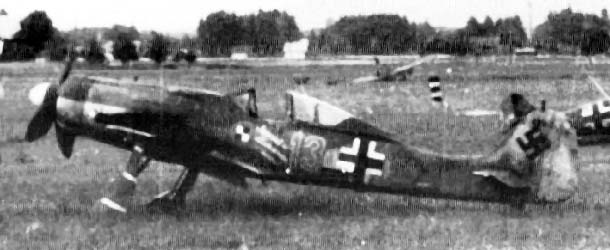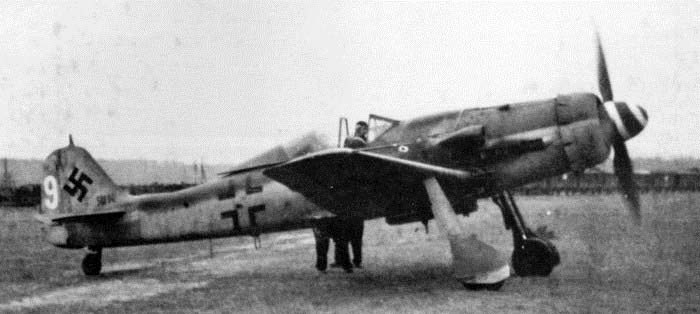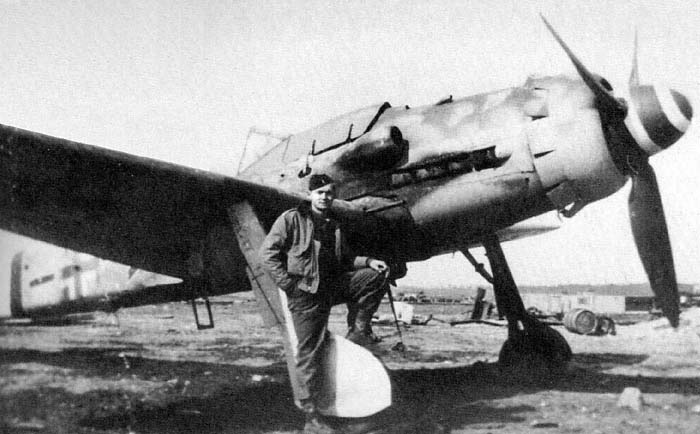The Focke-Wulf FW 190 (Shrike) was a German single-seat, single-engine fighter aircraft designed by Kurt Tank in the late 1930s and widely used during World War II.
The Focke-Wulf FW 190 was initially powered by a radial engine, had ample power, and was able to lift larger loads than its well-known counterpart, the Messerschmitt Bf 109. The 190 was used by the Luftwaffe in a wide variety of roles, including day fighter, fighter-bomber, ground-attack aircraft and, to a lesser degree, night fighter.
The FW 190 D (nicknamed the Dora; or Long-Nose Dora, "Langnasen-Dora") was intended to improve enough on the high-altitude performance of the A-series to make it useful against the American WW2 heavy bombers of its era that ruled the skies. In actuality, the D series was rarely used against the heavy-bomber raids, as the circumstances of the war in late 1944 meant that fighter-versus-fighter combat and ground attack missions took priority. The German factories produced a total of 1,805 D-9s, starting in August 1944.
Starting with the D version, the power plant was changed from the radial engine of earlier models to a 12-cylinder inverted-V, liquid-cooled engine. The Jumo 213A engine could generate more power and grant superior performance, in both speed and height.
To fit the new engine in the FW 190 fuselage while maintaining proper balance, both the nose and the tail of the aircraft were lengthened, adding nearly 1.52m to the fuselage in comparison to A-9 series. The lengthened tail required a straight-sided bay and to further aid balance, the pilot's oxygen bottles were moved aft and located in the new bay, giving the rear fuselage a “straightened” look.
Furthermore, a V12 engine required more components to be factored into the design, most significantly the need for coolant radiators. To keep the design as simple and as aerodynamic as possible, Tank used an annular radiator installed at the front of the engine, similar to the configuration used in the Jumo powered versions of the Junkers Ju 88.
The canopy was also changed, with the newer rounded top "blown" canopy first used on the A-8 model. With the canopy changes, the shoulder and head armor plating design was also changed. The centerline weapons rack was changed to an ETC 504 with a simplified and much smaller mounting and fairing.
In addition, Junkers produced a kit to increase manifold pressure (Ladedrucksteigerungs-Rüstsatz) that increased greatly engine output, effective up to 5,000 meters altitude. This kit was immediately fitted into D-9s delivered to the units in September, or retrofitted in the field by TAM. By the end of December, all operational Doras were converted, 183 in total.
After further improvements, such as the methanol-water injection, the Focke-Wulf FW 190 D was able to reach a maximum speed of 680 km/h (422 mph) at 6,600 meters (21,650 ft) altitude. Its 2,240 horsepower gave it an excellent acceleration in combat situations. It also climbed and dived more rapidly than the Fw 190A, and so proved well suited to dive-and-zoom ambush tactics.
Many of the early models were not equipped with tanks for the methanol boost system, which was in very short supply in any event. At low altitude, the top speed and acceleration were inferior to those of Allied fighters.
As it was used in the anti-fighter role, armament in the Focke-Wulf FW 190D was generally lighter when compared to earlier aircraft. Usually, the outer wing cannons were dropped so the armament consisted of two 13 mm MG 131, with 400 rounds per gun, and two 20 mm MG 151/20E cannon with 250 rounds per gun; all four weapons were synchronized to fire through the propeller arc.
The Dora was probably the best prop-driven, production Luftwaffe fighter of the war, but by late 1944, it was too late for the Dora to have an impact on war. Shortages of fuel and trained pilots constrained everything. While many FW 190D-9's were built, relatively few saw combat, frequently covering the Me 262 airfields.
The Focke-Wulf 190 D-13 started with the construction of two prototypes, and the 20 mm MG 151/20 cannon was found to be quite well suited for the aircraft. It was already well known to be effective against allied bombers, and was an effective ground support weapon. Thus, the FW 190 D-13/Rüstsatz 11 (/R11) version was selected to enter production.
The new version of this aircraft was implemented with new improvements, such as the all-weather flying equipment, systems for steering and autopilot, a new radio system (known as Hermine), and a heated windscreen. Pilots reported, due to the large amounts of torque produced by the engine, they usually used the steering system during the takeoff run, as it helped with the rudder movements. The D-13 also introduced a hydraulic boost system for the ailerons, which was later used on the Ta 152.
Over 20,000 FW 190's were built. While no flying models exist, many survive nowadays in aviation museums.
In the next article, you will learn about the history and the pilots of the three Focke-Wulf FW-190Ds presented in the WW2 Wings of Glory Airplane Packs.
Information sources: Wikipedia, AcePilots.com, WW2 Vehicles, Stof's "Virtual Flying" Page.













